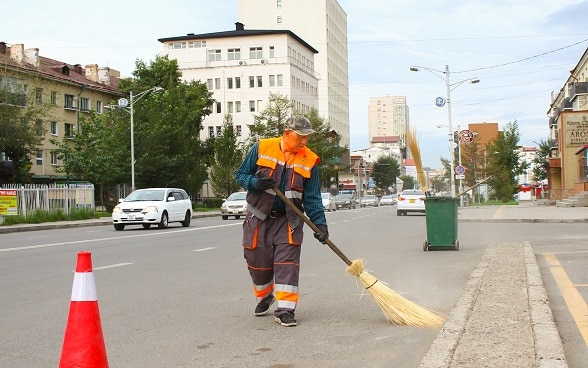
One reason for illegal dumping and the burning of waste in residential areas is the lack of proper waste collection and transportation management across the city, including the ger areas. Dumping and burning waste poses a huge risk of environmental harm and health risks in particular. There has been no segregation of waste in the past, little awareness of waste management, and the capital had an ineffective waste collection fee system.
To solve these problems, the Municipal Waste Collection and Transportation Management in Ulaanbaatar (WCTM) project has been implemented since 2019 with support from the Swiss Agency for Development and Cooperation (SDC). This project focused on waste collection and transportation only, which had been identified as the weak link between waste producers (people) and dumpsites.
SDC, the Municipality of Ulaanbaatar, city residents, private waste collection companies (TUKs), the international waste management company COWI, the Mongolian company ICON, and the Swiss company EBP are particularly proud of the following results achieved:
At the service delivery level: A simple waste segregation program was introduced in two districts, adapted to the population’s knowledge level and completed by a district-level material recycling facility. Waste is now regularly picked up from households by TUKs, weighed, sorted, and then transported to a disposal site or handed over to recycling companies. To monitor the system’s efficacy, digital tools were put in place and are now in the hands of the Municipality of Ulaanbaatar to monitor waste collection. The system utilizes QR codes on waste bins and GPS-based apps to follow the routes of waste collection trucks. Similarly, a truck weighing system has been put in place at the entry and exit points of waste disposal sites, directly connected to the municipality’s digital waste monitoring system. This not only directly affected the capacity to generate a range of reliable statistics but also had a direct impact on the reduction of petty corruption committed by truck drivers and civil servants at the disposal site.
Awareness raising was also important to the project. Different approaches were taken, including an early waste education program for schools, with concepts introduced through short plays, and the public event Eyereg Davlagaa (Positive Wave) held in each district to inform the public and encourage action. Surveillance cameras were installed at different illegal dumping sites, with corresponding action taken to discourage people from illegally dumping their waste. The project determined that cameras play an important role in detecting illegal dumping and any significant criminal violations in monitored locations. The advantage of cameras is that they can be moved to a new location when there are no more violations at well-monitored locations. The cameras were solar-powered and had built-in memory, not requiring a connection to a fiber optic cable. Introducing waste management and recycling at primary and secondary schools, and even at the kindergarten level, through plays proved to be important for inspiring behavioural change in the next generation.
The new Waste Law provides a shift from a waste fee calculated per household to a fee per capita. This is key for the financial sustainability of the entire waste management system. This project proved that effective cooperation between local governments, administrators, specialists, and residents can build a better environment.
For more information, please visit Eyereg Davalgaa page
